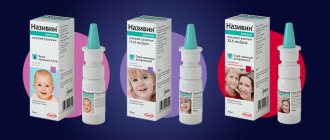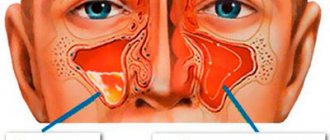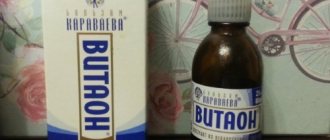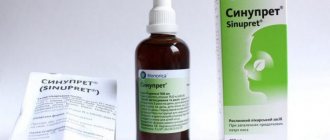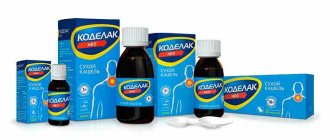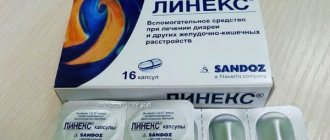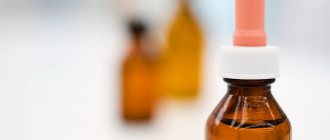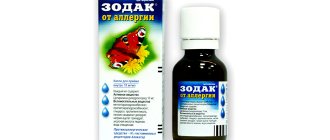If children have a cold and their nose is not breathing, the drug Nazol will cope perfectly with the problem. The main effect of the medicine is its ability to constrict blood vessels and relieve swelling. The drug is quite safe and effective for children, has minor side effects, which can be avoided by strictly following the instructions.
Composition, dosage form
Phenylephrine hydrochloride is the active ingredient in Nazol Baby drops. This chemical compound gives the drug a therapeutic effect. Additional components:
- inorganic compound - sodium dihydrogen phosphate;
- antiseptic component - benzalkonium chloride;
- organic compound - disodium salt of ethylenediaminetetraacetic acid;
- synthetic substance – ethylene glycol polymer;
- inorganic compound - potassium dihydrogen phosphate;
- trihydric alcohol - glycerol;
- base - purified water.
Auxiliary components give the drops additional properties and provide the necessary consistency.
Nazol Baby is produced in the form of nasal drops for topical use. The transparent medicinal solution has no color or distinct odor. The medicine is packaged in polypropylene bottles. One cardboard box contains a bottle of 5, 10, 15 or 30 ml with a built-in dropper dispenser. The branded cardboard packaging comes with an insert containing a detailed description.
The manufacturer is the Italian pharmaceutical company Instituto De Angeli, the representative in Russia is Bayer CJSC.
Compound
The active component of the drug Nazol Baby is phenylephrine. This is an alpha-adrenergic agonist - a stimulator of alpha-adrenergic receptors in the nasal mucosa. When applied topically, it causes a narrowing of the vascular network lining the mucosa, due to which swelling and hyperemia of the nasopharynx, Eustachian tube and paranasal sinuses are eliminated, nasal congestion is relieved, and the clinical signs of rhinitis disappear almost completely. Read more about vasoconstrictor drops for children →
In addition to phenylephrine, Nazol Baby drops contain additional components: glycerol, benzalkonium chloride, disodium salt, distilled water. All of these substances help maintain the therapeutic properties of phenylephrine and maintain the proper concentration of the drug.
Glycerol, which is part of the drug, moisturizes the nasal mucosa, eliminating dryness and burning, which are common side effects of vasoconstrictor drops.
Mechanism of action
The therapeutic effect is based on phenylephrine. This active substance is an adrinomimetic that affects alpha adrenergic receptors. Restoring breathing through the nose is mainly achieved through the coordinated work of three components:
- phenylephrine – constricts blood vessels;
- glycerin – softens the mucous membrane;
- benzalkonium chloride - has an antiseptic effect.
A well-chosen composition has a gentle effect on the child’s nasal mucosa, without causing irritation and dryness. During the therapy period, no unpleasant sensations bother you.
A short course of using drops can quickly eliminate a child’s runny nose and relieve all the unpleasant symptoms of rhinitis. Signs of the disease finally recede after 3-5 days from the start of therapy. Systemic absorption is negligible when drops are used topically. The therapeutic effect occurs 5-10 minutes after instillation. The vasoconstrictor effect lasts 6 hours.
Read more How to use Vidisik eye drops: instructions and reviews
Main indications
Acute and chronic rhinitis in children with colds and flu is the main indication for prescribing the medicine. Nazol Baby nasal drops are also prescribed for diseases of the ENT organs accompanied by nasal congestion. These include:
- atrophic rhinitis is a chronic inflammatory lesion of the nasal mucosa, characterized by atrophy of the mucous membrane;
- frontal sinusitis is a severe manifestation of sinusitis, characterized by inflammation of the frontal sinuses and infection;
- allergic rhinitis – nasal congestion due to an allergic reaction;
- sinusitis - inflammatory processes in the maxillary sinuses;
- Otitis media is an inflammatory process that develops in the middle ear.
The product is also used to eliminate swelling of the paranasal sinuses before diagnostic measures and operations. Nazol Kids is a type of drug that is prescribed to patients over the age of six.
Contraindications
According to the instructions for use of the drop, Nazol cannot be used in the presence of the following conditions:
- children up to 2 months;
- congenital and acquired cardiac pathologies;
- severe renal failure;
- sensitivity to the components of the drug;
- diabetes;
- hepatitis;
- tachycardia;
- arrhythmia;
- angina pectoris;
- hypertension;
- thyrotoxicosis.
There is little experience in using the medication in children under two months of age, pregnant and lactating women. If there are no risks to the fetus, patients are treated under the supervision of a specialist.
Instructions and dosage
According to the instructions, Nazol Baby for children is used intranasally, that is, by instillation into the nasal cavity. The product begins to work within a few minutes after contact with the mucous membrane.
The drug can be used starting from birth.
In childhood, it is prescribed in the following dosages:
- For children under one year of age, 1 drop of Nazol Baby is instilled into each nasal passage;
- For children over 12 months, the amount of the drug can be increased to 2 drops;
- Children from 2 to 6 years old are prescribed 3 drops.
This is an approximate drug prescription regimen. The doctor must select the exact dose of Nazol Baby on an individual basis, focusing on the disease and characteristics of the child. Sometimes it is not at all necessary for a 6-year-old child to drop 3 drops of the drug into each nostril 3 times a day: perhaps just one drop will be enough for this little patient to relieve the symptoms of a runny nose.
If several children in a family become ill at the same time, it is recommended that each patient purchase an individual package of nasal drops. It is unhygienic to use the same bottle for treatment, as this can lead to infection of all family members. After each instillation procedure, the tip of the bottle should be wiped with a sterile bandage and hermetically sealed.
The frequency of use of the drug is limited to two or three procedures per day. The course of treatment with any drug whose active ingredient is phenylephrine should not exceed 7 days. On average, to obtain a noticeable therapeutic effect, it is enough to carry out a short course of treatment of 3 days. If nasal congestion and rhinitis do not go away within this period, further self-medication is contraindicated; consultation with a pediatrician and replacement of the drug is necessary. These drops can also be prescribed to older patients. Nazol Baby is a popular vasoconstrictor drug during pregnancy. But there is no need to abuse it, since phenylephrine, despite its positive qualities, is a serious substance with its own side effects. Treatment with Nazol Baby in pregnant and nursing mothers should be carried out if there are appropriate indications.
The instructions for the drug recommend instilling 3-4 drops of the drug into each nasal passage for children over 6 years of age and adult patients.
Method of application, dosage regimen
The instructions for nasal drops Nazol Baby for children indicate standard schemes. Children under one year old are prescribed 1 drop, children from one year to 6 years old can put 2 drops into the nose. From 6 years old, the use of 4-5 drops in each nasal passage is recommended. Frequency of use – 4 times a day. The interval between instillations should be at least 6 hours. Therapy lasts no more than five days. The dosage regimen is selected by the doctor individually for each patient.
Before starting the procedure, a number of preparatory measures should be carried out:
- the bottle with the solution is heated in the palms;
- the nasal cavity is cleared of mucus using a solution of sea salt;
- instillation is carried out in a lying position;
- lift the tip of the baby’s nose with your fingers;
- instill the solution into one nostril, then into the other.
Read more Tsiprolet eye drops - instructions, analogues
The tip of the dropper bottle should not come into contact with the baby's nasal opening. Experts advise after instillation to massage the nose using circular movements.
Drops or spray
There are several forms of release of this drug that are convenient for children. Firstly, the form that is already classic for many is Nazol drops, its other name is Nazol Advance . Thanks to the properties of the substances that make up the medicine, you can quickly, effectively, and most importantly, gently relieve nasal congestion. Such drops act for quite a long time and the effect of one application can last half a day. But Nazol Advance cannot be used by infants, since it contains substances that irritate the child’s nasal mucosa and cannot ensure complete safety for the baby’s health.
The next release form is Nazol spray . Already in the name it is clear how this drug differs from the previous one - the convenient release form with a spray nozzle ensures excellent administration of the drug and ease of use. The advantage of the spray attachment is that using the drug, the risk of overdose is significantly reduced. One injection - one dose.
Another type of drug is Nazol Kids . This drug is designed specifically for children. The composition includes the substance phenylephrine, which is the safest when applied to children; it acts gently, without irritating the child’s mucous membranes. The nozzle is also in the form of a spray, the effectiveness of which was mentioned above.
And the last form on the list is Nazol Baby . This, just like Nazol Kids, contains substances that are as safe as possible for children. Nazol Baby contains eucalyptus extract to keep baby's nose moisturized. A distinctive feature of Nazol Baby is the presence of a convenient pipette. Nazol Baby can be given to children up to one year old and the pipette makes it very easy to administer the medicine into the nose.
Side effects, overdose
Nazol Baby drops are well tolerated by children. Only in rare cases may side effects occur in the form of:
- headache;
- vasomotor rhinitis;
- nausea, vomiting;
- dizziness;
- tremors of the limbs;
- insomnia;
- increased heart rate;
- tachycardia;
- hypertension;
- pale skin.
Burning, tingling or tingling in the nose are local reactions. Nosebleeds occur as a result of prolonged therapy due to excessive dryness of the mucous membrane. The listed consequences occur only with long-term use of the drug, as well as with increasing dosage.
Systemic signs of overdose occur when the dosage regimen is violated and the drops are used for a long time. Nervous agitation, severe migraine-type headache, joint and muscle pain, arrhythmia, hypertension, depression, increased sweating are undesirable consequences. If these symptoms appear, you need to call an ambulance. Inpatient treatment may be required. To relieve signs of overdose, alpha or beta blockers are prescribed.
Special instructions for the use of the drug Nazol baby
Before use, tilt the patient's head back and turn the bottle over, holding it above the nasal passage. In this position, the product is released in drops. Use the bottle individually to avoid the spread of infection. The persistence of swelling of the nasal passages within 3 days of using the drug may indicate the presence of a deviated nasal septum, purulent sinusitis, adenoid vegetations, allergic rhinitis, persistent bacterial infection or other undiagnosed diseases that require consultation with a specialized specialist and specialized complex therapy.
special instructions
Before starting therapy with Nazol Baby drops, you should familiarize yourself with the following special recommendations:
- Therapy with a medicinal solution does not need to be carried out together with other nasal drugs with a vasoconstrictor effect.
- The medicine Nazol Baby is used for babies strictly as prescribed by a specialist.
- Patients who have been treated with monoamine oxidase inhibitors (MAOIs) less than 14 days ago should be prescribed the medication with caution.
Pregnant and lactating women are prescribed with caution. The attending physician assesses the potential risk to the fetus/infant. If possible, Nazol Baby is replaced with another medication approved for use in this group of patients.
Price and analogues
Compared to other drugs in this group, the price of Nazol is quite reasonable and amounts to approximately 150-170 rubles, depending on the region and pharmacy chain. Similar drugs can easily include nasal products such as Aqua Maris, which is purified sea water. The safety of this medicine is definitely higher; if Nazol is contraindicated for your child, then Aqua Maris is perfect, but in terms of effectiveness it is inferior to drugs with vasoconstrictor properties. The price of Aqua Marisa is about 250 rubles.
Another preparation based on sea water is Aqualor Baby. Suitable for children from birth, cleanses and relieves nasal inflammation, can be used every day as a preventive measure. Its price is 320 rubles
Otrivin Baby - the drug in separate dropper bottles is a saline solution. Otrivin Baby helps cleanse the nose and moisturize it, acts gently and effectively, and helps improve immunity. Can also be used from birth. The price of Otrivin Baby is 168 rubles.
Vibrocil is a drug that contains two active components. One helps in relieving nasal swelling, while the other helps reduce itching and sneezing. Vibrocil acts gently and effectively, and the safe substances included in its composition allow you to use the drug for up to 7 days. This drug relieves swelling of the nasal cavity and makes breathing easier. Its price is 245 rubles.
Additional Information
Shelf life is 2 years from the date of manufacture indicated on the original packaging. After opening the bottle, the medicinal solution is suitable for use for one year. Storage temperature range from 15 to 30°C. Store the drug in a dark place away from direct sunlight. Access to the medicine for children and pets is necessarily limited.
You can buy a nasal solution at any pharmacy without first presenting a prescription sheet.
The average price of one bottle of children's drops Nazol Baby 0.125%, 10 ml is in the range from 220 to 250 rubles.
Analogs
The following available analogues are available in pharmacies:
- Otrivin Baby;
- Tizin;
- Xylene;
- Rhinostop;
- Eucazoline Aqua;
- Xymelin;
- Nazivin;
- Snoop;
- Vibrocil.
Read more Drops Remens - instructions and reviews from women
The listed analogues of Nazol Baby are widely used in ENT practice. They have a therapeutic effect for rhinitis, effectively eliminating nasal congestion and normalizing nasal breathing. A pediatrician should select a vasoconstrictor and determine the dosage regimen.
